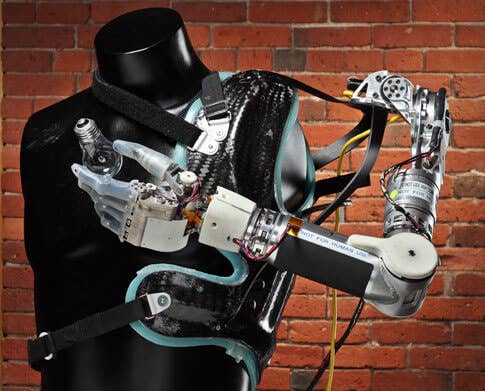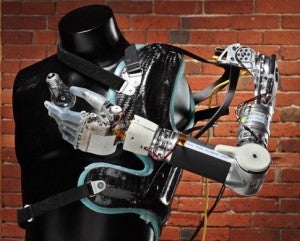Deka’s Luke Arm In Clinical Trials, Is it the Future of Prosthetics? (Video)

Share

The future of prosthetics isn't certain, and we've seen so many different next generation devices, it's hard to know which will ultimately arise as the standard. For legs, there are spring like mechanical struts that can outperform their biological counterparts, and there are complex electronic knees and feet that contain narrow artificial intelligence. Prosthetic hands, however, haven't evolved much in the past 60 years. But that's about to change. We've seen many different robotic hands in development, and one of the most popular in the press has been Deka's Luke Arm. Dean Kamen, inventor of the Segway scooter and head of Deka, helped design the electronic arm to fit the needs and desires of modern amputees. The Luke Arm went into clinical trials this summer and could become the prosthetic limb of choice for US soldiers returning from Iraq and Afghanistan. Yet, despite the Luke Arm's media presence (check out the 60 Minutes segment video after the break), I'm not certain it's going to beat the competition.
For those who missed our first story on Deka's Luke Arm, I should explain that it is controlled by pads under the feet and attached to shoulders muscles. Like a complex video game, users press on these pads to get the limb to perform desired actions. This is a robust system that allows for a precise level of control. It also takes a while to get used to. Competing prostheses, like i-Limb, use myoelectric sensors that can read nerve signals in muscles. Essentially, you think about moving your missing hand, and the prosthetic performs the action. The two approaches, joystick versus mind-control, seem grossly mismatched in the favor of the myoelectric sensors. How is the Deka arm staying competitive?
Well, largely I think the Luke Arm is winning because it is already able to start clinical trials, has Dean Kamen attached to the project, and is a remarkable piece of machinery. No doubt, the Luke Arm performs very well. It's customizable, modular, and robust. At only 8 lbs (3.6 kg), it contains electric motors that give it 18 degrees of freedom (the human arm has 22) and pressure control. A vibrating device, called a tactor, gives the user feedback sensation that allows him or her to stop the Luke Arm before it crushes an object. In the video you can see how the device is gentle and sensitive enough to pick up a grape.
https://www.cnet.com/av/video/flv/universalPlayer/universalSmall.swf
As mentioned, the Luke Arm is part of DARPA's Revolutionizing Prosthetics program. Deka received close to $18 million for the development of its device, but $30.4 million went to John Hopkins Applied Physics Lab for an alternate prosthetic that uses myoelectric sensors. That device, and APL researcher Jonathan Kuniholm, is shown towards the end of the 60 Minutes segment.
Be Part of the Future
Sign up to receive top stories about groundbreaking technologies and visionary thinkers from SingularityHub.


DARPA is hedging it's bets, spreading money around to see which projects will bear fruit. Smart idea. The Luke Arm's current trial utilizes the control pads we discussed earlier, but Kamen isn't ruling out the use of myoelectric sensors in the future. Between the APL and Deka, DARPA is bound to get at least one fieldable prosthetic very soon.
But if you're not a veteran, neither DARPA project may really help you much. The Luke Arm is slated to cost $100,000+, and a similar price is likely for the APL limb. That's well beyond the means of most amputees if they do not have the insurance coverage provided by the Veteran's Administration. The i-Limb is offered at a cheaper price (near $18,000) and is already being tested by 600 users. As most amputees are not veterans, I think that the Luke Arm has a good chance of being priced out of a large market share.
Which is why I was very interested in Jonathan Kuniholm's Open Prosthetics project. The same biomedical engineer working at APL (on the DARPA grant) is an advocate of open source solutions and hopes that a cheap and reliable alternative could be provided for those without the means to spend hundreds of thousands of dollars. Kuniholm gave an amazingly frank and thought-provoking interview to NPR's Fresh Air earlier in the month. He discussed the budget limitations of amputees, the bias non-amputees have on appearance over function, and the media's preference for hyperbolic stories (around 11:02). Give it a listen:
https://www.npr.org/v2/?i=120271945&m=120275632&t=audio
After hearing Kuniholm criticize the media for telling just two versions of technology stories ("this device is amazing, it's going to change everything" or "this device is a horrible waste of money") I am inclined to give a very measured outlook on the future of prosthetics. The Luke Arm is a great piece of machinery, and it's likely to be ready soon, but it could be too costly to own and too difficult to operate. Myoelectric devices could offer some amazing possibilities, but they aren't here yet. Surgically augmented devices, like the Smart Hand, could offer realistic feedback via nerve connections and completely outperform any other limb. But those devices are years from completion. The bottom line is that the first commercially available next-generation upper body prosthetic could be the Luke Arm, but it is certainly not going to be the last. Whichever device eventually sets the standard for limb replacement will have to be adaptable, affordable, and above all functional. May the best hand win.
[photo credit: IEEE Spectrum]
[video credit: 60 minutes via CNET]
[audio credit: NPR Fresh Air]
Related Articles

These Robots Are the Size of Single Cells and Cost Just a Penny Apiece

In Wild Experiment, Surgeon Uses Robot to Remove Blood Clot in Brain 4,000 Miles Away

A Squishy New Robotic ‘Eye’ Automatically Focuses Like Our Own
What we’re reading